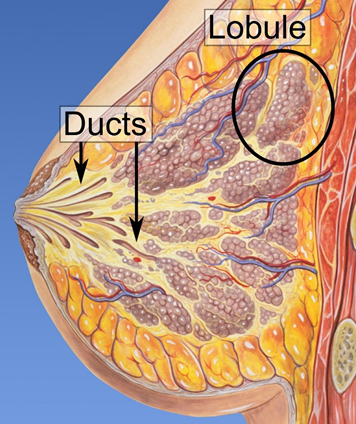Although by far, the most common breast cancer types are invasive ductal carcinoma (IDC) and ductal carcinoma in situ (DCIS), there are other types that are less commonly seen.
Invasive Lobular Carcinoma
Invasive lobular cancer (ILC) arises from the lobules of the breast glands. It accounts for 5-10% of all invasive breast cancer. The diagnosis of ILC is challenging because it does not have the typical clinical presentation or radiological appearance as the other types of breast cancer. It does not usually form a definitive lump, which makes it harder to discover by the patient or the doctor. Its appearance on breast images could be deceiving as the extent of the disease in the breast is frequently larger than what appears on the mammogram and ultrasound. Therefore, your doctor may request a breast MRI.
The treatment and prognosis of ILC depends on the subtype and stage of the cancer. However, the early the diagnosis is made and the treatment is started, the better the outcome will be.

Medullary Carcinoma
Medullary carcinoma accounts for 3-5% of all breast cancer types. The tumor usually shows up on a mammogram, but does not always feel like a lump. At times, it feels like a spongy change of breast tissue.
Tubular Carcinoma
Making up about 2% of all breast cancer diagnosis, tubular carcinoma cells have a distinctive tubular structure when viewed under a microscope. It is usually found through a mammogram and is a collection of cells that can feel like a spongy area of breast tissue rather than a lump. Typically this type of breast cancer is found in women aged 50 and above and usually responds well to hormone therapy.
Mucinous Carcinoma (Colloid)
Mucinous carcinoma represents approximately 1% to 2% of all breast cancers. The main differentiating features are mucus production and cells that are poorly defined. It also has a favorable prognosis in most cases.
Paget Disease Of The Breast Or Nipple
This condition (also known as mammary Paget disease) is a rare type of cancer affecting the skin of the nipple and often the areola, which is the darker circle of skin around the nipple. Most people with Paget disease evident on the nipple also have one or more tumors inside the same breast; generally either ductal carcinoma in situ or invasive breast cancer. Paget disease is frequently misdiagnosed at first because the first noticeable symptoms can easily be confused with more common skin conditions affecting the nipple. Like all breast cancers, the prognosis for Paget disease depends on a variety of factors, including the presence or absence of invasive cancer and whether or not it has spread to nearby lymph nodes.




